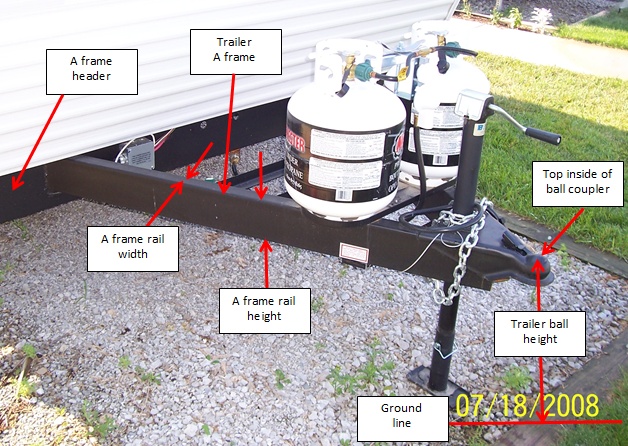Hi,
No worries on getting back to me. Thanks for the info. Your F150 has a higher receiver rating then the older F150's. They use to be in the lower to mid 900# range. And in the case of this 2003 T2570, that helps having the 1,050# rating in weight distributing (WD) mode.
Sunline was really good about making sure the floor plans had good tongue weight per the gross vehicle weight. Having good tongue weight helps the camper tow more stable naturally, a good thing. And different floor plans affect the loaded tongue weight more than others.
Your floor plan, a rear kitchen, loads weight at the back wall as that is where the cabinets, fridge and kitchen is. But, there is a good amount of storage up front, the bathroom has some weight and the front bedroom cabinets, under the bed and the front cargo hole helps balance out the heavier rear kitchen.
By the 2003 brochure and by the UVW sticker in the camper, I am estimating the unloaded camper tongue weight to be approx. 720# which is 14.9% tongue weight per 4,821# camper weight. This includes the LP gas in the tanks and a battery but does not yet include cargo in the camper.
Most camper folks end up adding an average of 1,000# of cargo by the time they have food, clothes, pot/pans, camping gear, spare tire, LP gas, battery etc. It sounds like a lot, but really is not. With your floor plan you could come in with a "loaded" tongue weight in the 900 to 1,000# and at the moment, that is without filling the fresh water tank to tow it to camp. More on the water in a moment.
Assuming the 1,000# of cargo added, to the UVW of 4,708# from the weight sticker, that can estimate out to a camper towing weight of 5,708#. You still have more capacity in the camper before you reach the 7,000# GVWR, but loading it all the way to the limit will be a lot (too much) for your truck.
If you want to know what adding fresh water in the tank when towing will be, tell me these dimensions and I can calculate what the water weight will add or subtract from the loaded tongue weight.
I would need these 2 dimensions. Approx within 1 to 2 inches. Place a tape measure along the ground and try to be as accurate as you can.
1. Distance from the center of the tow ball coupler (at the ball) to the center of the front axle of the camper.
2. Distance from the center of the tow ball coupler (at the ball) to the center of fresh water tank as you would be looking at it down the center of the camper.
I have the tank gallons capacity and can create an estimate on the tongue weight change when water is added. Then you can see if you can haul full fresh water or only partial.
Granted, all this is estimated. The only real way to know for sure is to weigh the camper once you load it all up. But I can get you in the ballpark at least.
I would say you need a WD hitch rated for 1,000 # and manage the camper to not exceed that loaded tongue weight. That fits with your truck receiver and most likely your truck rear axle limit & GVWR. You will need to limit your weight in the truck bed as with a 900 to 1,000# tongue weight on the camper, you can run out of truck rear axle capacity before you run out of room in the truck bed. Hopefully you do not have a truck cap, as they can be 300# by themselves.
If you would like, I can suggest several brands of WD hitches that would work with the camper and line up with your truck receiver. Let me know if you have any brand preferences.
And if you want me to size up the WD hitch, I need these 2 dimensions:
Ball height: I need the ball height now (before you do the axle flip) so I can get the right size WD shank on the hitch. Ball height of the camper is, have the camper on level ground, level out the camper (using a level of some kind on the inside floor of the camper over the axles) with the tongue jack, and then measure from the ground up to inside the ball coupler. I suspect on that year and model, it is between 17" to 18". Like this:
 Truck receiver height:
Truck receiver height: Put the limited number of must have things in the truck bed, bikes, lawn chairs etc. but leave out lots of firewood. That will settle the truck height to start from. Try to be conservative as you can't haul a lot and fill the bed. Then with the truck on level ground, full tank of gas, measure from the ground up to the top of the 2" truck receiver. Like this:

I will take into account you might do an axle flip. If you know for sure you will flip the axles, let me know and it will save 1 calculation. I can calculate with and without the flip as needed. The way WD hitches are packaged and pending your truck and camper heights, you may need a seperate WD shank to level out the camper when towing. Knowing the heights before you start hitch shopping helps make better decisions when buying.
I took some time to explain all this, sorry for the long post. It was to help guide you and so you can learn about your truck and the WD hitch on how to set them up optimally, the first time.
Hope this helps.
John
























 Linear Mode
Linear Mode




